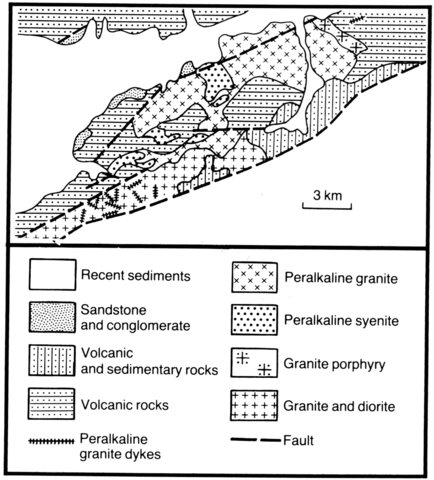stripes
This occurrence is associated with a system of faults and extends over about 22 km in a zone which is roughly 4-6 km wide. Generally the main intrusion truncates volcanic rocks, including trachyrhyolites, comendites, trachybasalts and trachyandesites, as well as normal granites. The margins of the intrusion are very irregular, which is partly due to the approximately horizontal contact with the roof, which is close to the present erosion level. At the contacts the country rocks are hornfelsed and in some places the metamorphism has led to the development of K-feldspar in the enclosing rocks which are also intersected by dyke-like apophyses of fine-grained peralkaline granite. The intrusion is composed mainly of aegirine-riebeckite granites which are of a lilac or light grey colour. They were preceded by coarse-grained peralkaline syenites which have remained intact within granites in the form of bodies up to 2.5 x 1 km2. Two textural varieties are distinguished amongst the peralkaline granites: coarse- to medium-grained and medium- to fine-grained. The latter, as a rule, forms veins and dykes from 5-10 cm up to 10 m wide, which cut the coarser grained granites. The peralkaline granites contain alkali feldspar, aegirine, riebeckite and quartz. Prismatic crystals of plagioclase (An33-36) are poikilitically included in K-feldspar in the peralkaline syenites and colourless clinopyroxene is surrounded by an alkali amphibole fringe.
ZANVILEVICH, A.N., LITVINOVSKY, B.A. and ANDRE’E V, G.V. 1985. The Mongolian-Transbaikalian alkali-granitoid province (geology and petrology). Nauka, Moscow. 232 pp.

